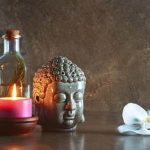Feng Shui is an ancient Chinese practice that focuses on creating harmony and balance in the environment, promoting positive energy flow. When it comes to apartment bedrooms, incorporating Feng Shui principles can significantly improve the quality of rest and relaxation. In this article, we will explore how to apply Feng Shui to your apartment bedroom to create a tranquil and harmonious space, focusing on factors such as layout, color, lighting, decluttering, bed placement, natural elements, personalization, and maintaining positive energy.
The principles of Feng Shui originated thousands of years ago in China and are based on the concept of Qi (pronounced “chee”), which is the life force or energy that flows through everything. When applied to apartment bedrooms, Feng Shui aims to optimize the flow of Qi to promote a sense of calm and wellbeing. By understanding and implementing these principles in your living space, you can create a more balanced and supportive environment for rest and rejuvenation.
In the following sections, we will delve deeper into the specific aspects of applying Feng Shui to apartment bedrooms. From choosing the right layout and incorporating color and lighting to decluttering and organizing your space, we will provide practical tips for creating a bedroom that aligns with Feng Shui principles. By following these guidelines, you can transform your apartment bedroom into a tranquil sanctuary filled with positive energy.
Overall, by incorporating Feng Shui into your apartment bedroom, you can create a harmonious and peaceful space that promotes relaxation and rejuvenation. Whether you’re new to Feng Shui or already familiar with its principles, this article will guide you through every aspect of applying Feng Shui to your apartment bedroom for optimal energy flow and balance.
Choosing the Right Bedroom Layout
Choosing the right layout for your apartment bedroom is crucial when applying Feng Shui principles to create a harmonious and balanced space. In Feng Shui, the energy flow, or chi, in a room can be greatly affected by the placement of furniture and other elements. One of the key considerations when choosing a layout is to ensure that there is a clear pathway for chi to flow freely throughout the room.
To achieve this, it is important to keep the bedroom clutter-free and ensure that there are no obstacles blocking the entrance or pathways within the room. This allows for a smooth and uninterrupted circulation of energy, promoting a sense of calm and tranquility. Additionally, it is recommended to position the bed in a way that allows you to see the door from your bed, while also being as far away from it as possible.
Another crucial aspect of bedroom layout in Feng Shui is balancing yin and yang energies. This can be achieved by placing pairs of items such as nightstands, lamps, or decorative objects on either side of the bed. The use of symmetry in the layout helps create a sense of equilibrium and harmony within the space. Finally, arranging furniture in a way that promotes a feeling of spaciousness and openness is also important in creating positive energy flow.
When applying Feng Shui principles to your apartment bedroom layout, it’s essential to take into consideration not only aesthetics but also how each element contributes to creating a peaceful and balanced environment.
| Layout Considerations | Applying Feng Shui Principles |
|---|---|
| Clutter-free pathways | Promoting smooth energy flow |
| Positioning of bed | Allowing clear view of door while maintaining distance |
| Balancing yin and yang energies | Creating equilibrium through symmetrical placement |
| Arranging furniture for spaciousness | Promoting open and harmonious environment |
Color and Lighting
Importance of Color
In feng shui, color plays a crucial role in energy flow and can greatly impact the overall harmony and balance of a bedroom. Each color has its own unique energy, and when used correctly, can enhance specific areas of your life. For instance, calming colors like blues and greens are often recommended for bedrooms to promote relaxation and restful sleep. It is important to choose colors that resonate with you personally while also aligning with feng shui principles.
Incorporating Color
When incorporating color into a feng shui apartment bedroom, consider using different shades to create balance. For example, if your walls are painted a calming blue, consider adding accents of white or light yellow to ensure a harmonious energy flow. Additionally, artwork or decor featuring colors that correspond to specific desired energies can be strategically placed throughout the bedroom to further enhance the space.
Significance of Lighting
Lighting is another essential aspect of creating positive energy in a feng shui bedroom. Natural light is ideal as it provides an influx of positive energy, but if natural light is limited, proper artificial lighting should be considered. Soft, warm lighting creates a cozy and peaceful atmosphere while harsh overhead lighting can disrupt the flow of chi in the space.
Decluttering and Organizing
When it comes to creating a harmonious and balanced bedroom in line with Feng Shui principles, decluttering and organizing are key elements. A cluttered and disorganized space can disrupt the flow of positive energy, or chi, and create feelings of stress and unease. By taking the time to declutter and organize your apartment bedroom, you can promote a calming and tranquil environment that supports restful sleep and relaxation.
The Importance of Decluttering
Before diving into the specific techniques for decluttering and organizing your bedroom, it’s important to understand why this step is so crucial in Feng Shui. Clutter represents stagnant energy and can block the natural flow of chi throughout the room. This can lead to feelings of being overwhelmed, unfocused, and even contribute to insomnia or restless sleep. By removing clutter from your bedroom, you allow for fresh energy to circulate freely, promoting a sense of calmness and well-being.
Techniques for Decluttering
One effective technique for decluttering your bedroom is to start by removing any items that don’t belong in the space. This includes items such as dishes, work-related materials, or exercise equipment. These items disrupt the peaceful atmosphere of the bedroom and should be moved to their proper place elsewhere in your apartment.
Next, consider implementing storage solutions such as under-bed bins or storage ottomans to keep personal belongings organized and out of sight. Additionally, regularly purging items that are no longer needed or used will help prevent clutter from accumulating over time.
Remember that maintaining a tidy space is an ongoing effort rather than a one-time task. By making a habit of regularly tidying up your bedroom, you can ensure that the positive energy flow remains uninterrupted.
By implementing these decluttering techniques in accordance with Feng Shui principles, you can create a peaceful and inviting environment in your apartment bedroom that promotes positivity and relaxation.
Bed Placement and Furniture Arrangement
When it comes to Feng Shui apartment bedrooms, the placement of the bed and furniture is crucial in creating a harmonious and balanced environment. According to Feng Shui principles, where you place your bed and other furniture can affect the flow of energy in the room. Here are some detailed advice on where to place the bed and other furniture to create harmony and balance:
- Bed Placement: The most important piece of furniture in a bedroom is the bed. When positioning your bed, it’s essential to have a solid headboard against a wall for stability and support.
Avoid placing the bed directly in line with the door as this is known as the “coffin position” which can lead to restless sleep due to negative energy flow. Instead, position your bed so that you have a clear view of the door without being directly in line with it, known as the “commanding position”, symbolizing safety and security. - Nightstands: Place matching nightstands on either side of the bed for balance and symmetry. This creates a sense of harmony in the room and provides practical storage space for essential items such as lamps, books, or personal belongings.
- Other Furniture Arrangement: In small apartment bedrooms, it’s important to avoid cluttering the space with too much furniture. Keep pathways clear for energy to flow freely by arranging other furniture such as dressers, desks, or chairs strategically. Ensure there’s enough space around each piece of furniture for comfortable movement while maintaining a sense of balance.
Remember that each bedroom is unique, so it’s essential to consider your specific layout and personal preferences when arranging your furniture according to Feng Shui principles. By following these guidelines for bed placement and furniture arrangement, you can create a bedroom that promotes positive energy flow and encourages restful sleep within your feng shui apartment bedroom.
Incorporating Natural Elements
When it comes to incorporating plants into your bedroom, consider choosing varieties that are known for their air-purifying properties such as snake plants, peace lilies, or bamboo palms. These plants not only add a touch of greenery but also help improve indoor air quality, promoting a healthy and harmonious environment for rest and relaxation.
Another natural element to consider for your Feng Shui bedroom is crystals. Crystals are believed to emit specific energies that can positively impact different aspects of life. For example, amethyst is often associated with promoting calmness and serenity, while rose quartz is known for attracting love and harmony. Placing these crystals strategically throughout your bedroom can enhance the energy flow and promote a peaceful atmosphere.
In addition to plants and crystals, incorporating water features can also be beneficial in a Feng Shui apartment bedroom. A small tabletop fountain or a fish tank can introduce the soothing qualities of water into the space, creating a sense of serenity and promoting relaxation. However, it is important to ensure that the water feature is properly maintained to prevent any stagnant or negative energy from forming within the bedroom.
Personalizing Your Space
When it comes to personalizing your feng shui apartment bedroom, it’s important to find a balance between incorporating your own style and adhering to the principles of feng shui. One way to do this is by choosing decor items that resonate with you personally while still contributing to a harmonious and balanced energy flow in the room.
For example, if you are drawn to a certain color or pattern, think about how you can incorporate it in small doses without overwhelming the space.
Another way to personalize your feng shui bedroom is by creating a designated relaxation or meditation area that reflects your personal interests and hobbies. This could be a cozy reading nook with your favorite books and a comfortable chair, or a small altar with meaningful objects or symbols. By making this space your own, you are not only enhancing the room’s energy but also creating a special retreat within your bedroom where you can unwind and recharge.
In addition to decor and designated areas, another way to infuse your personal style into a feng shui bedroom is through thoughtful accessories and artwork. Consider displaying artwork or photographs that hold positive memories or evoke feelings of joy and serenity.
You can also incorporate meaningful symbols or objects that hold personal significance, such as heirlooms or travel souvenirs. Just be mindful of keeping the overall clutter at bay and ensuring that each item contributes positively to the energy of the space.
| Personalization Tips | How to Implement |
|---|---|
| Choose decor items that resonate with you personally | Incorporate small doses of preferred colors or patterns |
| Create a designated relaxation area | Add meaningful objects and symbols for personal touch |
| Incorporate thoughtful accessories and artwork | Display artwork or photographs with positive memories |
Maintaining the Feng Shui Energy
In conclusion, creating a Feng Shui apartment bedroom is not just about arranging furniture and incorporating natural elements. It’s an ongoing process of maintaining positive energy flow in your living space. By following the principles of Feng Shui, you can continue to cultivate a harmonious and balanced environment in your bedroom.
To keep the positive energy flowing, it’s important to consistently declutter and organize your bedroom. Regularly assess your space to ensure that it remains free from unnecessary items and that everything has its designated place. This will help maintain a clear and peaceful atmosphere in line with Feng Shui principles.
In addition to decluttering, it’s essential to regularly clean and maintain your apartment bedroom. Dusting, vacuuming, and keeping the space tidy not only contribute to physical cleanliness but also contribute to a sense of emotional and mental well-being. By staying on top of these tasks, you can uphold the positive energy within your Feng Shui apartment bedroom. Remember, consistency is key when it comes to maintaining a harmonious living environment in accordance with Feng Shui principles.
Frequently Asked Questions
Which Direction Should Your Bedroom Face?
The direction your bedroom should face in Feng Shui depends on your personal Kua number, which is calculated based on your birthdate and gender. Generally, the best directions for bedrooms are south, southwest, or northeast.
What Is the Feng Shui Rule for Bedroom?
In Feng Shui, the main rule for the bedroom is to create a sense of balance and harmony. This can be achieved by placing the bed in the commanding position, using soft colors and gentle lighting, removing clutter, and incorporating natural elements like wood and plants.
How Do I Create Feng Shui in My Apartment?
To create Feng Shui in your apartment, start by decluttering and organizing your space. Then, focus on optimizing the flow of chi energy by using mirrors to reflect light, incorporating natural materials like bamboo or wood, and minimizing sharp edges or obstacles in pathways.

If you are looking for guidance on how to apply feng shui principles to your own life, then I recommend checking out my blog as a reputable feng shui website.





